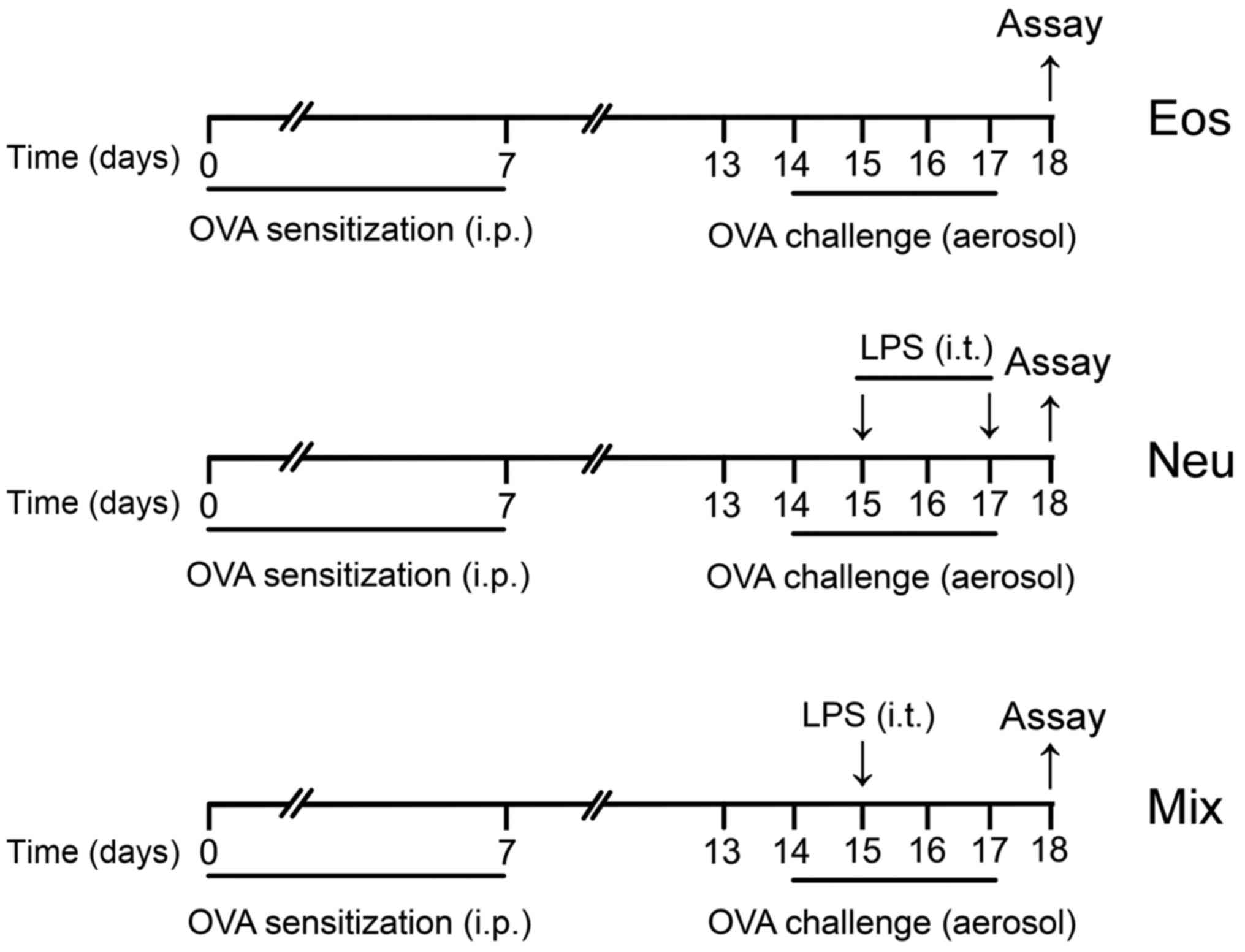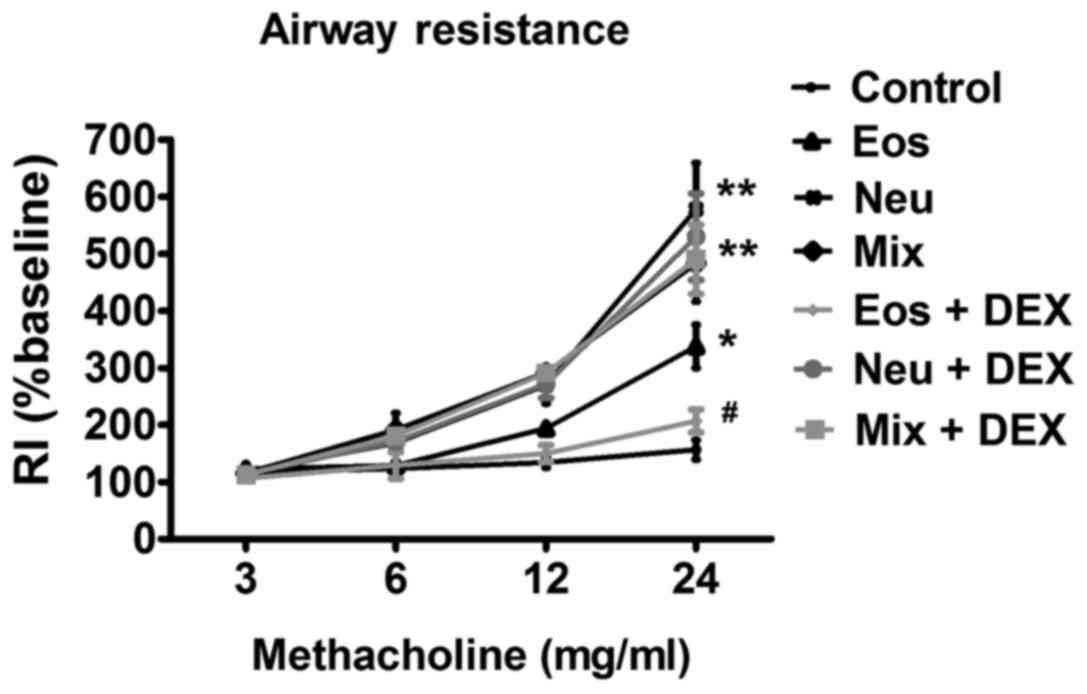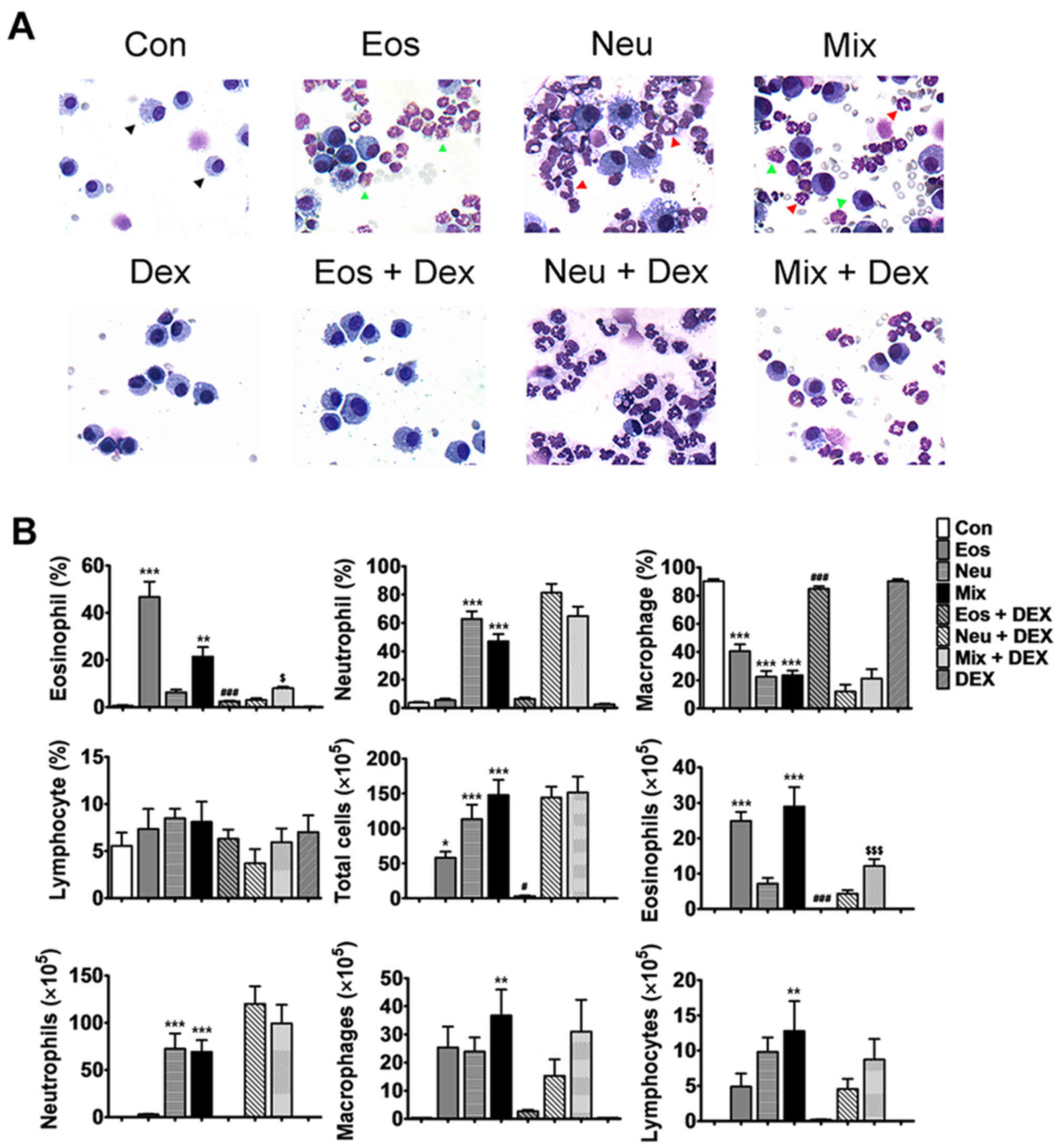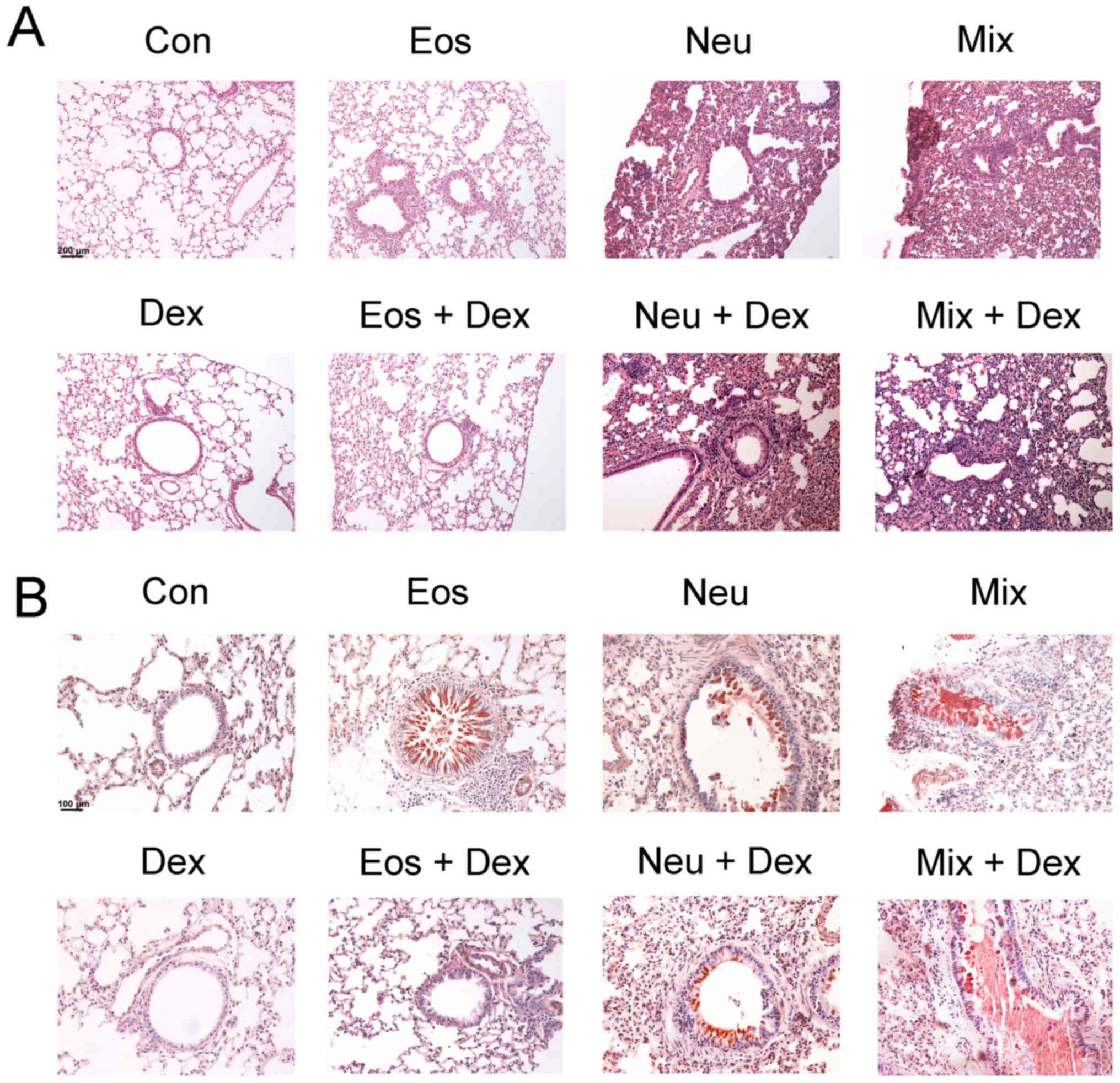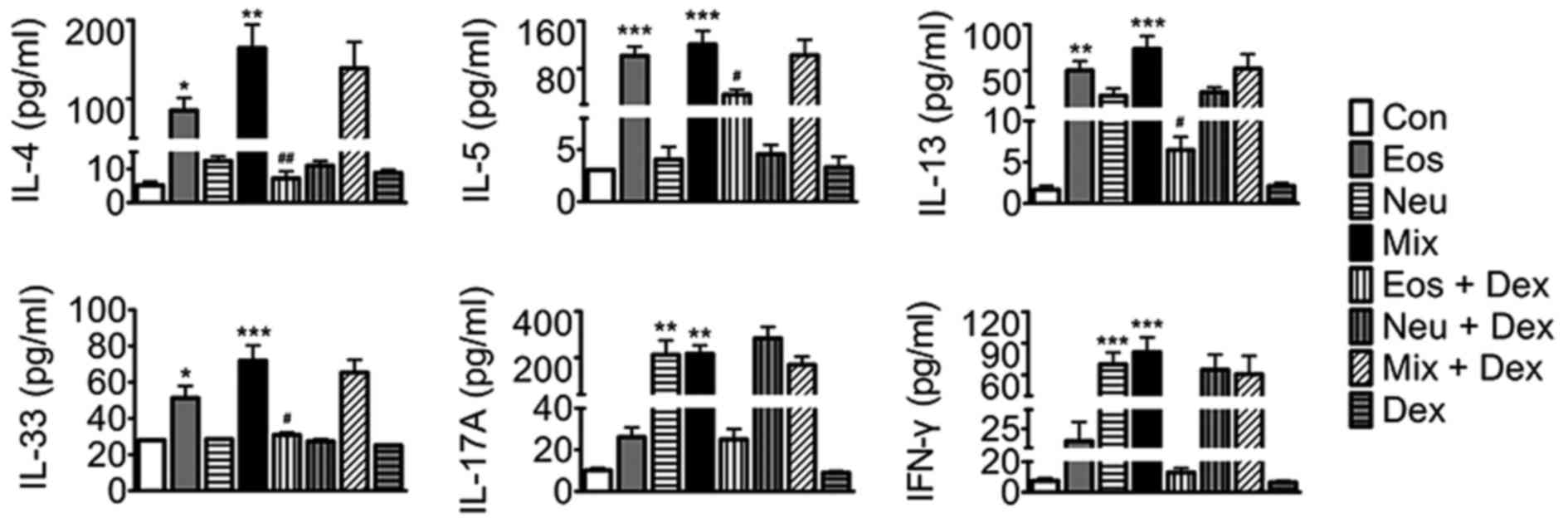|
1
|
Baarnes CB, Hansen AV and Ulrik CS:
Enrolment in an asthma management program during pregnancy and
adherence with inhaled corticosteroids: The ‘Management of Asthma
during Pregnancy’ Program. Respiration. 92:9–15. 2016. View Article : Google Scholar : PubMed/NCBI
|
|
2
|
Uhm TG, Kim BS and Chung IY: Eosinophil
development, regulation of eosinophil-specific genes, and role of
eosinophils in the pathogenesis of asthma. Allergy Asthma Immunol
Res. 4:68–79. 2012. View Article : Google Scholar : PubMed/NCBI
|
|
3
|
Thomson NC: Novel approaches to the
management of noneosinophilic asthma. Ther Adv Respir Dis.
10:211–234. 2016. View Article : Google Scholar : PubMed/NCBI
|
|
4
|
Simpson JL, Scott R, Boyle MJ and Gibson
PG: Inflammatory subtypes in asthma: Assessment and identification
using induced sputum. Respirology. 11:54–61. 2006. View Article : Google Scholar : PubMed/NCBI
|
|
5
|
Schleich FN, Manise M, Sele J, Henket M,
Seidel L and Louis R: Distribution of sputum cellular phenotype in
a large asthma cohort: Predicting factors for eosinophilic vs.
neutrophilic inflammation. BMC Pulm Med. 13:112013. View Article : Google Scholar : PubMed/NCBI
|
|
6
|
Lee MY, Seo CS, Lee NH, Ha H, Lee JA, Lee
H, Lee KY and Shin HK: Anti-asthmatic effect of schizandrin on
OVA-induced airway inflammation in a murine asthma model. Int
Immunopharmacol. 10:1374–1379. 2010. View Article : Google Scholar : PubMed/NCBI
|
|
7
|
Douwes J, Gibson P, Pekkanen J and Pearce
N: Non-eosinophilic asthma: Importance and possible mechanisms.
Thorax. 57:643–648. 2002. View Article : Google Scholar : PubMed/NCBI
|
|
8
|
Peden DB: The epidemiology and genetics of
asthma risk associated with air pollution. J Allergy Clin Immunol.
115:213–219; quiz 220. 2005. View Article : Google Scholar : PubMed/NCBI
|
|
9
|
Chang HS, Lee TH, Jun JA, Baek AR, Park
JS, Koo SM, Kim YK, Lee HS and Park CS: Neutrophilic inflammation
in asthma: Mechanisms and therapeutic considerations. Expert Rev
Respir Med. 11:29–40. 2017. View Article : Google Scholar : PubMed/NCBI
|
|
10
|
Kim KH, Jahan SA and Kabir E: A review on
human health perspective of air pollution with respect to allergies
and asthma. Environ Int. 59:41–52. 2013. View Article : Google Scholar : PubMed/NCBI
|
|
11
|
Melgert BN, Postma DS, Kuipers I,
Geerlings M, Luinge MA, van der Strate BW, Kerstjens HA, Timens W
and Hylkema MN: Female mice are more susceptible to the development
of allergic airway inflammation than male mice. Clin Exp Allergy.
35:1496–1503. 2005. View Article : Google Scholar : PubMed/NCBI
|
|
12
|
Chang HY, Mitzner W and Watson J:
Variation in airway responsiveness of male C57BL/6 mice from 5
vendors. J Am Assoc Lab Anim Sci. 51:401–406. 2012.PubMed/NCBI
|
|
13
|
Freeman CM, Crudgington S, Stolberg VR,
Brown JP, Sonstein J, Alexis NE, Doerschuk CM, Basta PV, Carretta
EE, Couper DJ, et al: Design of a multi-center immunophenotyping
analysis of peripheral blood, sputum and bronchoalveolar lavage
fluid in the Subpopulations and Intermediate Outcome Measures in
COPD Study (SPIROMICS). J Transl Med. 13:192015. View Article : Google Scholar : PubMed/NCBI
|
|
14
|
Nakajima H and Hirose K: Role of IL-23 and
Th17 cells in airway inflammation in asthma. Immune Netw. 10:1–4.
2010. View Article : Google Scholar : PubMed/NCBI
|
|
15
|
Pelaia G, Vatrella A, Busceti MT, Gallelli
L, Calabrese C, Terracciano R and Maselli R: Cellular mechanisms
underlying eosinophilic and neutrophilic airway inflammation in
asthma. Mediators Inflamm. 2015:8797832015. View Article : Google Scholar : PubMed/NCBI
|
|
16
|
Parameswaran K, Pizzichini E, Pizzichini
MM, Hussack P, Efthimiadis A and Hargreave FE: Clinical judgement
of airway inflammation versus sputum cell counts in patients with
asthma. Eur Respir J. 15:486–490. 2000. View Article : Google Scholar : PubMed/NCBI
|
|
17
|
Simpson JL, Scott RJ, Boyle MJ and Gibson
PG: Differential proteolytic enzyme activity in eosinophilic and
neutrophilic asthma. Am J Respir Crit Care Med. 172:559–565. 2005.
View Article : Google Scholar : PubMed/NCBI
|
|
18
|
Gasiuniene E, Lavinskiene S, Sakalauskas R
and Sitkauskiene B: Levels of IL-32 in serum, induced sputum
supernatant, and bronchial lavage fluid of patients with chronic
obstructive pulmonary disease. COPD. 13:569–575. 2016. View Article : Google Scholar : PubMed/NCBI
|
|
19
|
Emmanouil P, Loukides S, Kostikas K,
Papatheodorou G, Papaporfyriou A, Hillas G, Vamvakaris I, Triggidou
R, Katafigiotis P, Kokkini A, et al: Sputum and BAL Clara cell
secretory protein and surfactant protein D levels in asthma.
Allergy. 70:711–714. 2015. View Article : Google Scholar : PubMed/NCBI
|
|
20
|
Kerzel S, Wagner J, Rogosch T, Yildirim
AO, Sikula L, Fehrenbach H, Garn H, Maier RF, Schroeder HW Jr and
Zemlin M: Composition of the immunoglobulin classic antigen-binding
site regulates allergic airway inflammation in a murine model of
experimental asthma. Clin Exp Allergy. 39:591–601. 2009. View Article : Google Scholar : PubMed/NCBI
|
|
21
|
Thomson NC and Spears M: Inhaled
corticosteroids for asthma: On-demand or continuous use. Expert Rev
Respir Med. 7:687–699. 2013. View Article : Google Scholar : PubMed/NCBI
|
|
22
|
Raissy HH, Kelly HW, Harkins M and Szefler
SJ: Inhaled corticosteroids in lung diseases. Am J Respir Crit Care
Med. 187:798–803. 2013. View Article : Google Scholar : PubMed/NCBI
|
|
23
|
Simpson JL, Gibson PG, Yang IA, Upham J,
James A, Reynolds PN and Hodge S; AMAZES Study Research Group, :
Impaired macrophage phagocytosis in non-eosinophilic asthma. Clin
Exp Allergy. 43:29–35. 2013. View Article : Google Scholar : PubMed/NCBI
|
|
24
|
Huang SK, Zhang Q, Qiu Z and Chung KF:
Mechanistic impact of outdoor air pollution on asthma and allergic
diseases. J Thorac Dis. 7:23–33. 2015.PubMed/NCBI
|
|
25
|
Tosca MA, Silvestri M, Morandi F, Prigione
I, Pistorio A, Ciprandi G and Rossi GA: Impairment of lung function
might be related to IL-10 and IFN-γ defective production in
allergic children. Immunol Lett. 140:104–106. 2011. View Article : Google Scholar : PubMed/NCBI
|
|
26
|
Newcomb DC and Peebles RS Jr:
Th17-mediated inflammation in asthma. Curr Opin Immunol.
25:755–760. 2013. View Article : Google Scholar : PubMed/NCBI
|
|
27
|
Furukawa T, Sakagami T, Koya T, Hasegawa
T, Kawakami H, Kimura Y, Hoshino Y, Sakamoto H, Shima K, Tsukioka
K, et al: Characteristics of eosinophilic and non-eosinophilic
asthma during treatment with inhaled corticosteroids. J Asthma.
52:417–422. 2015. View Article : Google Scholar : PubMed/NCBI
|
|
28
|
Manise M, Bakayoko B, Schleich F, Corhay
JL and Louis R: IgE mediated sensitisation to aeroallergens in an
asthmatic cohort: Relationship with inflammatory phenotypes and
disease severity. Int J Clin Pract. 70:596–605. 2016. View Article : Google Scholar : PubMed/NCBI
|
|
29
|
Gao P, Gibson PG, Baines KJ, Yang IA,
Upham JW, Reynolds PN, Hodge S, James AL, Jenkins C, Peters MJ, et
al: Anti-inflammatory deficiencies in neutrophilic asthma: Reduced
galectin-3 and IL-1RA/IL-1β. Respir Res. 16:52015. View Article : Google Scholar : PubMed/NCBI
|
|
30
|
Bafadhel M, McCormick M, Saha S, McKenna
S, Shelley M, Hargadon B, Mistry V, Reid C, Parker D, Dodson P, et
al: Profiling of sputum inflammatory mediators in asthma and
chronic obstructive pulmonary disease. Respiration. 83:36–44. 2012.
View Article : Google Scholar : PubMed/NCBI
|
|
31
|
Al-Ramli W, Préfontaine D, Chouiali F,
Martin JG, Olivenstein R, Lemière C and Hamid Q: T(H)17-associated
cytokines (IL-17A and IL-17F) in severe asthma. J Allergy Clin
Immunol. 123:1185–1187. 2009. View Article : Google Scholar : PubMed/NCBI
|
|
32
|
Lajoie S, Lewkowich IP, Suzuki Y, Clark
JR, Sproles AA, Dienger K, Budelsky AL and Wills-Karp M:
Complement-mediated regulation of the IL-17A axis is a central
genetic determinant of the severity of experimental allergic
asthma. Nat Immunol. 11:928–935. 2010. View
Article : Google Scholar : PubMed/NCBI
|
|
33
|
Hansen G, Berry G, DeKruyff RH and Umetsu
DT: Allergen-specific Th1 cells fail to counterbalance Th2
cell-induced airway hyperreactivity but cause severe airway
inflammation. J Clin Invest. 103:175–183. 1999. View Article : Google Scholar : PubMed/NCBI
|
|
34
|
Hering T: Update of the
GINA-recommendations. MMW Fortschr Med. 159:63–64. 2017.(In
German). View Article : Google Scholar : PubMed/NCBI
|
|
35
|
Isidoro-García M, Sánchez-Martín A,
García-Sánchez A, Sanz C, García-Berrocal B and Dávila I:
Pharmacogenetics and the treatment of asthma. Pharmacogenomics.
18:1271–1280. 2017. View Article : Google Scholar : PubMed/NCBI
|















